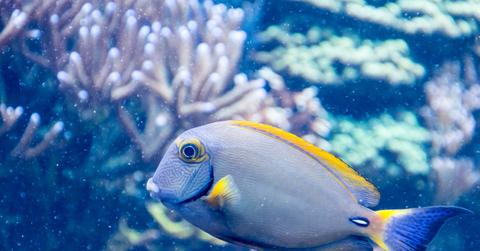These Tiny Beads Remove A Toxic Sunscreen Chemical From Oceans
The same UV-blocking chemical that helps sunscreen protect your skin causes serious damage to coral reefs. Now, lab researchers created tiny beads that can actually absorb the offending chemical right out of the ocean; leaving reefs intact.
Updated May 22 2019, 9:56 a.m. ET
The same UV-blocking chemical that helps sunscreen protect your skin causes serious damage to coral reefs. Now, lab researchers at the University of Puerto Rico have created tiny beads out of algae and lobster shells that can actually absorb the offending chemical right out of the ocean, leaving reefs (and your unburned skin) totally intact. It's not the whole solution, but it offers an optimistic step in the right direction.
Snorkelers and divers are unintentionally causing harm to coral reefs.
Snorkelers and divers will be the first to tell you how precious and delicate reefs are. Unfortunately, those are often the same people unwittingly doing damage to the areas they explore, when sunscreen that’s on the skin washes off underwater and comes in contact with coral. Oxybenzone, the UV-blocking chemical that functions as the active ingredient in most sunblock, wreaks havoc on reefs.
One study found that the chemical makes coral more prone to bleaching, damages the DNA of coral, causes abnormal skeletal growth, and correlates with serious deformities in baby coral. And that’s all in addition to what oxybenzone does to marine life.
Damage to reefs can occur when the concentration of oxybenzone in the water is around 62 parts per trillion. Yet in Hawaii, researchers found oxybenzone levels exceeded 700 parts per trillion even early in early mornings, before any swimmers had even arrived on the beach for the day.
Solving the coral reef problem goes beyond attempts at smart consumerism.
One obvious solution to this problem is for each of us to make the call as consumers to only buy marine- and reef-safe sunscreens. After all, a simple web search reveals any number of sunblock brands in a variety of price ranges, scents, and styles that won’t harm the ecosystem next time you don a pair of flippers and goggles.
But the reality is, until all companies make a universal effort to take oxybenzone out of sunscreen (and other personal care products), people are still going to buy harmful products. In other words, we need a Plan B for protecting the reefs. And that’s where the University of Puerto Rico researchers come in.
“We need to do something, and this may be a start,” Felix Roman, a chemistry professor at the University of Puerto Rico, told Fast Company. Roman’s lab works to figure out eco-friendly ways to clean up contaminated waterways. The scientists generally stick to solving crises in freshwater bodies, but made an exception in this case.
The scientists made the 3-millimeter beads out of alginate (from algae), iron oxide, chitosan (a waste product of fish found in things like lobster shells), iron oxide and sodium oleate.
“Coral bleaching by oxybenzone is a difficult problem, but not an impossible one,” Roman said in an American Chemical Society press release. “Our magnetite nanoparticles are magnetic, and we can make them specific to a particular pollutant—in this case oxybenzone—by altering the surface chemistry of these particles. But you don’t want to release loose nanoparticles into the environment, so we encapsulate them in a matrix that is environmentally friendly and cheap. The idea is that if you dump it in water, you can pull it out with a magnet.”
Adjusting the alginate/chitosan ratio, Roman explained, would allow the beads to float or sink to make chemical removal even simpler. After a busy day on a beach near a reef, the beads could be dumped into the water or dragged inside of a net by a boat.
In the group’s first round of testing, they used seawater spiked with oxybenzone at 30 parts per million. The beads were able to remove 95 percent of the oxybenzone in just one hour. Amazing, right?
